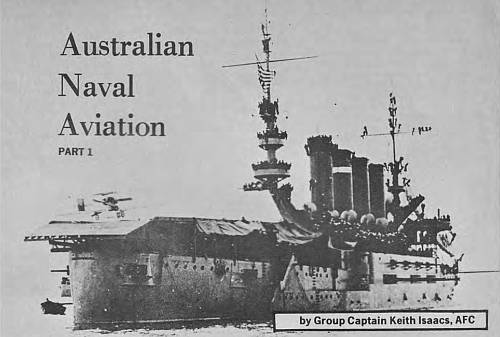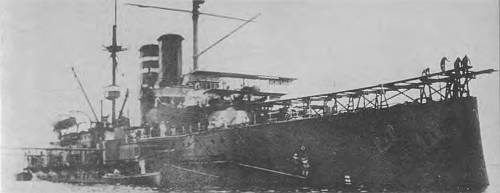- Author
- Issacs, Keith, AFC, ARAeS, Group Captain, RAAF (Retd)
- Subjects
- Naval Aviation
- Tags
-
- RAN Ships
- HMAS Brisbane I, HMAS Encounter I, HMAS Huon I, HMAS Yarra I, HMAS Una, HMAS Swan I, HMAS Pioneer, HMAS Australia I, HMAS Sydney I, HMAS Parramatta I, HMAS Melbourne I
- Publication
- December 1972 edition of the Naval Historical Review (all rights reserved)

Group Captain Keith Isaacs is well qualified to write about military aircraft for he has flown with three air forces – the Royal Australian Air Force, Royal Air Force and United States Air Force. He was born at Drummoyne, New South Wales, on May 30 1921 and educated at the local St. Mark’s School, and St. Joseph’s High School, Rozelle.
He entered the Citizen Military Forces in 1941, transferred to the Australian Imperial Force in 1942 and in December that year joined the Royal Australian Air Force. He qualified as a pilot and spent most of the next 17 years flying four-engined aircraft – Consolidated Liberators, Avro Lincolns and Lockheed Hercules of the RAAF, Handley Page Hastings on exchange duty with No. 24 (Commonwealth) Squadron, RAF and Lockheed C130As on attachment to the 61st Troop Carrier Squadron, USAF. He also flew VIP versions of the Liberator, Hastings and Douglas Dakota. During the latter years of this period he was Commanding Officer of two RAAF transport squadrons. He climaxed a career of over 5,000 hours in the air by flying at Mach 2 in a Dassault Mirage 111-D while he was Commanding Off8icer, Base Squadron, RAAF Williamtown. He was awarded an Air Force Cross for his flying duties.
Although he has held staff appointments in recent years he still managed to publicise the RAAF in his spare time. Some of these latter activities included restoration of historic RAAF aircraft for display, design of the RAAF Williamtown badge, introduction of the service paper Mirage, and presentation of historical articles in Aircraft magazine and RAAF News, including the authoritative series Aircraft of the RAAF. In 1971 he was elected a Companion of the Royal Aeronautical Society. He is at present a member of the Directorate of RAAF Jubilee Year, and was part-author of the best-selling The Golden Years: Royal Australian Air Force 1921-1971.
THE HISTORY OF WORLD naval aviation began, tentatively, in the lighter-than-air era. As far back as November 1861, during the American Civil War, the Union Army – employing maritime techniques – released the Washington balloon from a remodelled coal barge, the G.W. Parke Curtis, to observe the enemy at Budd’s Ferry. In 1877 Commodore Cheyne of the British Navy proposed using three balloons in an expedition to the North Pole, and other international developments included the establishment of a French Naval Balloon Corps, the attempts by the Russians to improve naval signalling by using balloons, and the Swedish Navy Coast Defence Balloon Ship of 1903.
That year American naval authorities showed interest in Dr. Samuel Langley’s ‘Aerodrome’ tandem-wing aircraft, which made two unsuccessful attempts to get airborne from a launching track on a houseboat. It was not until July 1 1911, however, that the United States Navy purchased its first aircraft, the Curtiss A-1 Triad amphibian, so named because of its ability to operate from land, sea and air. This purchase came after two historic ‘firsts’ had been carried out by Eugene Ely, a Curtiss demonstration pilot. Ely flew a Curtiss pusher land-plane on November 14 1910 from USS Birmingham, which was in Hampton Roads, Virginia, and on January 18 1911 landed and took off from USS Pennsylvania, anchored in San Francisco Bay. In each case special platforms had been erected on the cruisers. A month later, on February 17, Curtiss himself paid a flying visit to the Pennsylvania in San Diego Bay, where his seaplane was hoisted aboard and later lowered over the side for take off. These trials convinced the United States Navy that aircraft would be of use to warships and, in fact, could well become ‘the eyes of the fleet’. In November 1912 the Curtiss A-3 seaplane made the first successful launch from a catapult, and next month the Curtiss C-1 became the first flying boat to be catapult-launched; both experiments took place at the Washington Navy yard. Three years later, on November 5 1915, the Curtiss AB-2 flying boat made the first catapult launching from a battleship, the USS North Carolina.

Meanwhile the British Navy had also concentrated on heavier-than-air craft after an unhappy experience with No 1 Rigid Naval Airship, the Mayfly, which broke up on the water in a wind squall on September 24 1911. Two months later Commander O. Schwann, who was attached to the Naval Airship Tender Hermione but was acting in a private capacity, carried out the first seaplane takeoff from British waters on November 18, when he became airborne in an Avro Type D fitted with air-bag floats. The first seaplane flight in the world had already been made by H. Fabre in France on March 28 1910, and Curtiss made the first hydroplane flight in America on January 26 1911. On January 10 1912 one of the Royal Navy’s first pilots, Sub-Lieutenant C.R. Samson, flew a Short S.38 (also referred to as a modified Short S.27) from a specially built track of 100 feet on the foredeck of HMS Africa while the ship was at anchor. This same aircraft had been tested previously in December 1911 by the Australian, Sub-Lieutenant A.M. Longmore, when three airbags were attached to the undercarriage struts and tail unit to enable him to alight on the water. Still using the Short S.38, Samson repeated his take-off feat on May 9 1912, only this time the warship HMS Hibernia, which had been fitted with Africa’s aircraft ramp, was under way at Weymouth steaming at 10-15 knots.




